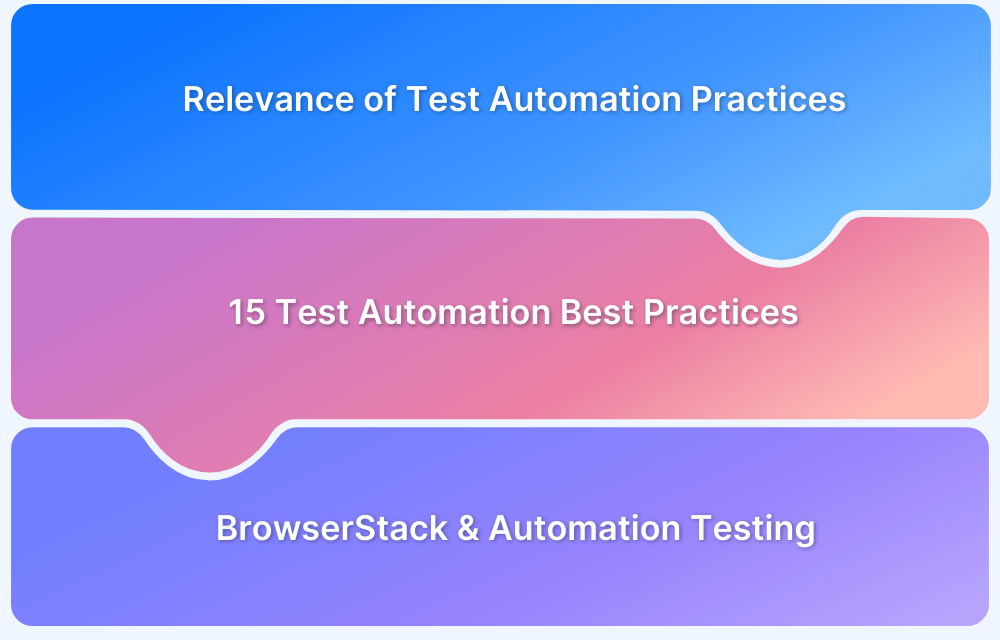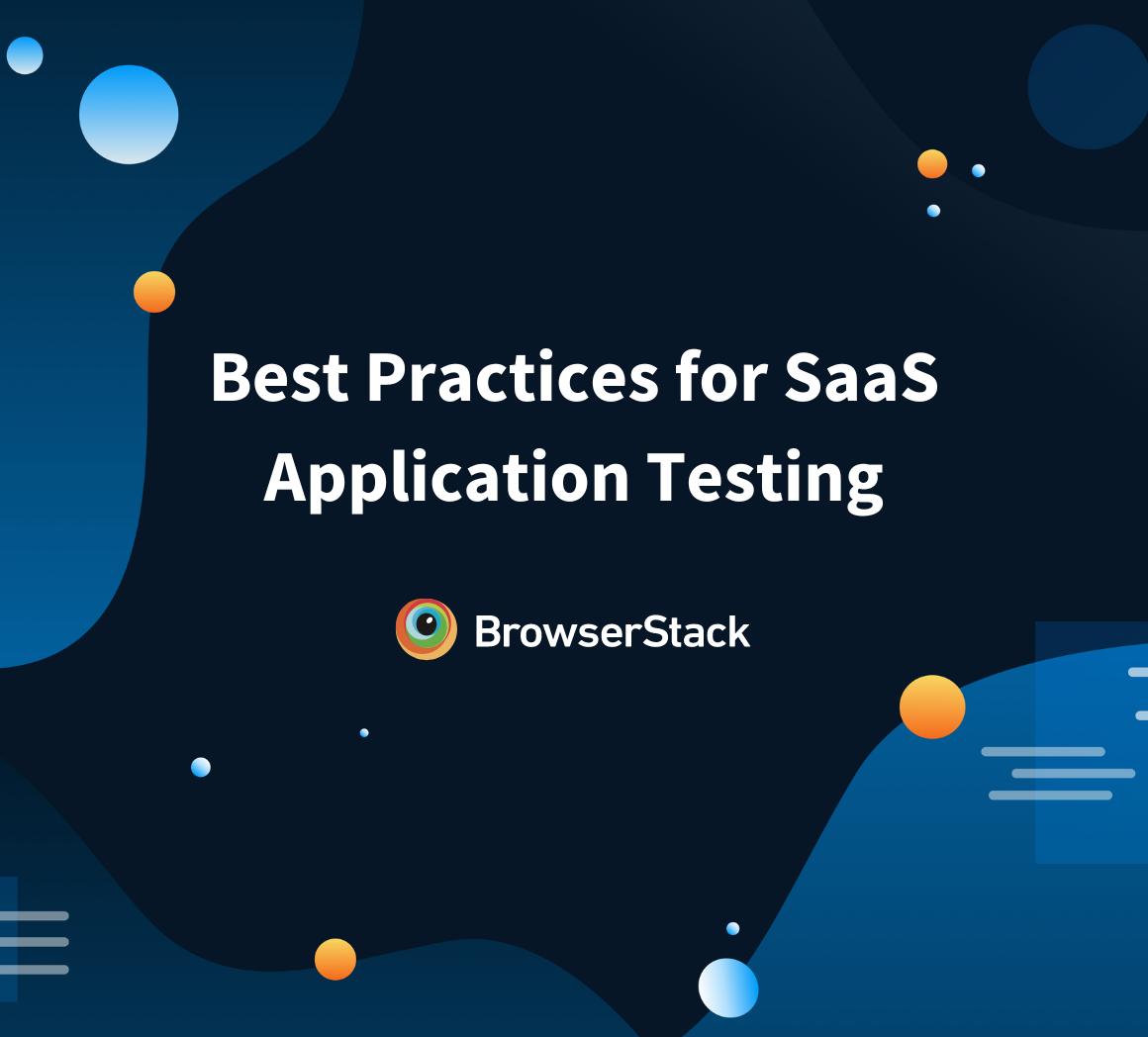Test automation is at the forefront of the transformation in the software development landscape, enabling teams to deliver high-quality software faster than ever before. Therefore, knowing and implementing the best practices in test automation is essential.
This article discusses 16 essential test automation best practices to help you stay ahead, ensuring your automation strategy is robust, scalable, and aligned with the latest industry trends.
16 Test Automation Best Practices to follow
Here are 16 essential test automation best practices to help facilitate fast, successful & accurate automation tests.
Test Automation Best Practices
- Start with a Clear Automation Strategy
- Prioritize Tests for Automation based on Value and ROI
- Use the Right Tools
- Design Modular and Reusable Test Scripts
- Implement Data-Driven Testing
- Incorporate Continuous Integration (CI)
- Focus on Test Maintenance
- Leverage Parallel Testing
- Implement Continuous Testing
- Adopt a Shift-Left Approach
- Build tests that adapt to UI changes
- Utilize AI and Machine Learning
- Ensure Cross-Browser and Cross-Platform Testing
- Maintain a Balanced Test Automation Pyramid
- Incorporate Robust Reporting and Analytics
- Foster Collaboration Between Teams
1. Start with a Clear Automation Strategy
Success in test automation necessitates careful planning and design. Begin by developing an automation plan. This allows you to determine the first set of tests to automate and serves as a guideline for subsequent testing. First, establish your purpose for automated testing and decide which sorts of tests to automate. There are several sorts of testing, and each has its own role in the testing process.
For example, unit testing is used to test a subset of the intended application. Functional or GUI testing is used to test a specific component of the application’s user interface.
2. Prioritize Tests for Automation
- Identify High-Value Tests: Automate tests that are used frequently, have a high impact, and are stable, such as regression and smoke tests. Avoid automating testing for features that change frequently or are experimental.
- Evaluate ROI: Think about the cost and benefit of automating each test case. Prioritize those with the best return on investment in terms of efficiency and defect detection.
To maximize the effectiveness of your automated testing efforts, consider automating:
- Repetitive tests run on many builds.
- Tests are prone to human errors.
- Tests requiring numerous data sets.
- Frequently used functionality that creates high-risk situations.
- Tests that are impossible to complete manually.
- Tests performed on several hardware or software platforms and configurations.
Read More: What is Test Case Prioritization?
3. Use the Right Tools
- Tool Selection: Select automation solutions that are compatible with your application’s technological stack (web, mobile, API) and meet your automation requirements (test management, reporting, integration).
- Evaluate features: Ensure that the tools provide key features such as simple scripting, robust reporting, and integration with other tools such as CI/CD pipelines.
Before you choose an automated testing tool, think about these important points:
- Platform and Technology Support: Ensure the tool supports the platforms and technologies you’re working with. For instance, does it handle .NET, C#, or WPF applications? Is it suitable for web applications, or does it support mobile testing across Android and iOS?
- Flexibility for All Skill Levels: Assess whether the tool accommodates testers with varying skill levels. Can your QA team write automated test scripts, or is there a need for a tool that offers keyword-driven testing?
- Feature-Rich Yet User-Friendly: Check if the tool offers robust features for creating automated tests, including both record-and-playback functionality and manual test creation. It should support implementing checkpoints to validate values, databases, or key application functionality.
- Reusability and Maintainability: Determine if the tool allows for the creation of reusable and maintainable automated tests that remain resilient to changes in the application’s UI.
- Integration with Existing Ecosystem: Verify that the tool integrates seamlessly with your current ecosystem, such as CI/CD pipelines (e.g., Jenkins or Azure DevOps), test management frameworks (e.g., Zephyr), defect management systems (e.g., Jira), and source control platforms (e.g., Git).
- Support for Enterprise Applications: Ensure the tool provides out-of-the-box support for testing enterprise applications, such as SAP, Oracle, Salesforce, and Workday.
Read More: Best Automation Testing Tools for 2024
4. Design Modular and Reusable Test Scripts
- Create Reusable Components: Create Automated test scripts with smaller and modular functions that can be reused across different tests. This reduces redundancy and simplifies maintenance.
- Use Page Object Models: Implement design patterns like the Page Object Model to abstract the details of the web pages or application components, making test scripts more maintainable.
5. Implement Data-Driven Testing
- Separate Test Data: Store test data in external files or databases rather than embedding it within test scripts. This allows for running the same tests with different data sets.
- Manage Data Sources: Use data-driven frameworks to easily manage and organize test data, improving test coverage and flexibility.
6. Incorporate Continuous Integration (CI)
- Automate Test Execution: Integrate automated tests into your CI pipeline to ensure tests are run automatically with each code change or build.
- Monitor Results: Set up notifications and dashboards to quickly identify and address test failures or issues that arise during CI builds.
7. Focus on Test Maintenance
- Regular Updates: Regularly review and update test scripts to keep them in sync with application changes. Remove obsolete tests and update existing ones as needed.
- Manage Test Flakiness: Address any flaky tests (tests that sometimes fail due to issues unrelated to the functionality being tested) to ensure reliable test results.
8. Leverage Parallel Testing
- Run Tests Simultaneously: Execute tests in parallel across multiple environments, browsers, or devices to reduce overall test execution time and increase efficiency.
- Optimize Test Environments: Set up parallel test environments that can handle simultaneous test runs to ensure comprehensive coverage.
9. Implement Continuous Testing
- Embed Testing Early: Integrate testing early in the development cycle to catch defects as soon as possible, rather than waiting until later stages. Implement a Continuous Testing strategy for DevOps for seamless testing.
- Automate Feedback: Provide continuous feedback to developers and stakeholders based on test results to facilitate quicker fixes and improvements.
10. Adopt a Shift-Left Approach
- Involve Automation Early: For Shift Left Testing, start automating tests from the earliest stages of development, such as unit testing, to identify and fix issues sooner.
- Collaborate with Developers: Work closely with developers to ensure that test automation is integrated into the development process from the beginning.
11. Build tests that adapt to UI changes
A crucial practice in automating tests is making sure they can handle UI changes, mostly in the early development stages. You can focus on object recognition as it relies on location coordinates. When unique, permanent names are assigned to controls, running automated tests without frequent name changes becomes easier. By doing so, you not only save time but also prevent issues in the long run.
12. Utilize AI and Machine Learning
- Enhance Test Case Selection: Use AI in Automation Testing, to analyze historical test data and predict which test cases are most likely to find defects, optimizing test coverage.
- Improve Test Execution: Apply machine learning in automation testing to detect patterns in test failures and automatically adjust test scripts to reduce flakiness.
13. Ensure Cross-Browser and Cross-Platform Testing
- Test on Multiple Browsers: Verify that your application works consistently across various web browsers (e.g., Chrome, Firefox, Edge) and versions with Cross Browser Testing.
- Support Diverse Devices: Ensure compatibility across different devices, screen sizes, and operating systems, particularly for mobile applications with Cross Platform Testing.
14. Maintain a Balanced Test Automation Pyramid
- Focus on Unit Tests: Prioritize automated unit tests, which are fast and provide early feedback on code quality.
- Layered Approach: Implement integration tests and fewer end-to-end tests to cover more complex scenarios, ensuring a balanced test automation strategy.
15. Incorporate Robust Reporting and Analytics
- Detailed Reports: Use comprehensive reporting tools to capture test execution results, defect details, and performance metrics.
- Visualize Trends: Utilize dashboards and analytics to monitor testing progress, identify trends, and make data-driven decisions for future improvements.
Pro Tip: One unified platform that will enable users to monitor, debug, and maximize their tests on BrowserStack successfully is BrowserStack Test Observability. It’s the best fix for test reporting and debugging since it lets auto-tag actual test failures
16. Foster Collaboration Between Teams
- Cross-Functional Teams: Encourage collaboration between QA engineers, developers, and operations teams to align on automation goals and address challenges collectively.
- Knowledge Sharing: Share insights and best practices across teams to enhance overall testing effectiveness and efficiency.
Why are Test Automation Best Practices important?
There are numerous reasons why test automation is advantageous, and by following automated testing best practices, you can maximize your return on investment (ROI) in testing. Automated testing reduces development cycles, eliminates cumbersome repetitive tasks, and enhances software quality. But how do you get started?
These best practices provide a solid foundation for improving your software quality.
Thorough testing is vital to the success of any software product. If your software doesn’t function properly, users are unlikely to buy or continue using it. However, finding defects—also known as bugs—is time-consuming, costly, repetitive, and prone to human error.
Automated testing, where Quality Assurance teams use software tools to run detailed, repetitive, and data-heavy tests automatically, helps improve software quality and optimizes the use of limited testing resources.
Test automation tools like the suites provided by BrowserStack enable teams to test faster, cover more code, improve test accuracy, and free up QA engineers to focus on tests that require manual intervention and their unique expertise.
Conclusion
In conclusion, selecting the right automated testing tool is crucial for enhancing your software quality and streamlining your testing processes. By considering factors such as platform support, flexibility for various skill levels, ease of creating and maintaining tests, integration capabilities, and support for enterprise applications, you can ensure that your tool aligns with your team’s needs and project requirements.
BrowserStack stands out as a powerful solution that addresses these critical considerations. With its extensive support for multiple platforms and technologies, BrowserStack enables teams to test across diverse environments seamlessly, including web and mobile applications on Android and iOS with Automate and App Automate products.
Its user-friendly interface supports both record-and-playback and manual test creation, accommodating testers of all skill levels. The platform’s robust integration with CI/CD pipelines, test management frameworks, and defect-management systems enhances collaboration and efficiency.
By leveraging BrowserStack, teams can simplify their automation efforts, reduce maintenance overhead, and achieve faster, more reliable test results. This ultimately leads to higher software quality and a more streamlined development lifecycle, helping your team stay competitive and deliver exceptional products.






